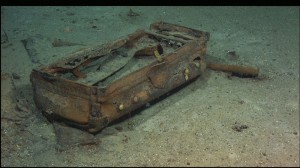 In lieu of the 100th anniversary of the sinking of the Titanic, this article, from Archaeology Magazine, details the process of the exploration of the Titanic as it has developed with the field of underwater archaeology and advances in deep-sea technology. I found it extremely interesting that it was not until very recently the underwater wreckage has been considered an archaeological site. In the most recent excavation in 2010, new underwater robotic vehicles were able to take 3-D photos of all areas of the ship, creating detailed site maps and allowing archaeologists to literally “walk on the decks of the ship.” Archaeologists have now begun the task of identifying the context of various artifacts, features. I was also intrigued by the ethical and legal issues that excavators have faced in the 25 years since the ship was discovered, which tie in to some of the same issues we have discussed with repatriation, leaving sacred artifacts untouched, why and how artifacts are removed from the ground (or the sea!) and what happens to them next.
In lieu of the 100th anniversary of the sinking of the Titanic, this article, from Archaeology Magazine, details the process of the exploration of the Titanic as it has developed with the field of underwater archaeology and advances in deep-sea technology. I found it extremely interesting that it was not until very recently the underwater wreckage has been considered an archaeological site. In the most recent excavation in 2010, new underwater robotic vehicles were able to take 3-D photos of all areas of the ship, creating detailed site maps and allowing archaeologists to literally “walk on the decks of the ship.” Archaeologists have now begun the task of identifying the context of various artifacts, features. I was also intrigued by the ethical and legal issues that excavators have faced in the 25 years since the ship was discovered, which tie in to some of the same issues we have discussed with repatriation, leaving sacred artifacts untouched, why and how artifacts are removed from the ground (or the sea!) and what happens to them next.
Reflections on Community and Public Archaeology
Presenting Archaeology to the Public, Spring 2012
